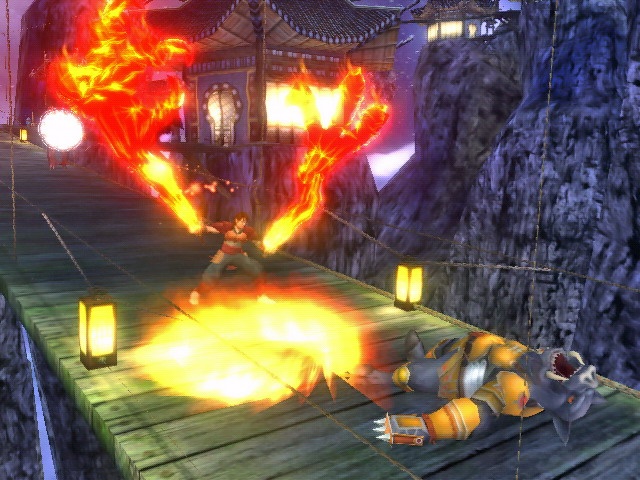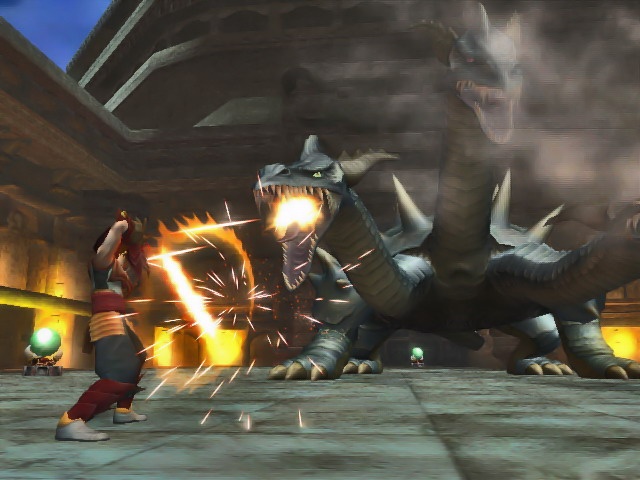You can tell by the randomly generated title that Dragon Blade isn't going for creative gusto. This game could have just as easily been called Dragon Fire: Wrath of Blade, Blade Wrath: Dragon of Fire, Dragon Fire Blade: Wrath Of, or Of Wrath, Dragons, Blades, and Colons. What it can never be is worth your money or time. This Wii-flinging hack-and-slash action game features a couple of decent boss fights, as well as a few interesting enemy encounters. However, its low budget, high price tag, fickle controls, and terrible cheapness keep it from being a game worth generating in the first place.
The most interesting detail about Dragon Blade is that its plot was penned by author Richard A. Knaak, author of such diverse titles as Dragon Hunt, Ice Dragon, The Crystal Dragon, and Day of the Dragon. In this, his latest opus, a good dragon named Valthorian enters human society until his five evil siblings take over the minds of humanity's rulers and convince them to chop Valthorian into little pieces. Somehow, the good dragon's soul is contained in a sword, which is found by a farm boy named Dal, right after some bad guys kill his girlfriend.
The rest of the plot goes as follows: Dal arrives at ruins. His sword says something to the effect of "This place used to be nice. Dragons messed it up." And then, in the name of a better tomorrow with higher property values, you fight stuff. Specifically, you fight wolves, bears, spiders, bats, lizard people, archers, orcs, minotaurs, and wizards. Those are the only enemies in the game, and although they change colors in later levels, they never behave any differently. Everywhere you go, lizard people are the same.
At least they die in different ways. As Dal, you can slash foes with your sword or subdue them with dragon magic. But before we get to things like the dragon punch, let's cover the basics. With flicks of the Wii Remote, you can hack and slash, while normal button presses will cause you to parry, roll, or jump. For the most part, you can just wag the Wii Remote like the tail of a dog to get your dirty deeds done. The only exception is the thrust, which requires a poking motion and nets you red crystals. These, in turn, fill your dragon magic bar.
It sounds simple, and indeed it is. But the game's interpretations of your motions are awfully subjective. You may be trying to slash but wind up poking--or vice versa. This can be bad because the poke is a slower attack and can leave you wide open to damage. The greater issue, though, is the fact that Dragon Blade is the gesture equivalent of a button masher, a Wiigler if you will. And it's impossible not to notice the poignancy of the effect. To get an idea of how this works, hold your hand in front of you like you're holding a Wii Remote then shake it back and forth at the wrist. You just summed up Dragon Blade.
To its credit, there are some bright spots. Two of every three levels feature a boss fight, and these tend to be pretty interesting. The dragons are big, they have the coolest-looking attacks in the game, and their fights take place in three stages. The first is a simple attack pattern, the second is a new attack pattern, and the third is a core break chance that mimics the cinematic battles from God of War, but without the style or violence. The other boss fights pit you against the human kings turned wicked by dragon magic. Each possesses one of Valthorian's body parts, and when you defeat them, you gain a special attack associated with that part.

For instance, right off the bat, you defeat a guy with a dragon hand. From then on, pressing right on the D pad will turn your sword into a giant, flaming dragon paw. By swiping or poking with the Wii Remote, your attacks will do much more damage and consume dragon power. Although you gain a handful of powers by the end of the game, the dragon punch is the only one you'll regularly use. It is mana efficient, and one smack can fell most standard enemies.
Even though you only have to kill them once, the kings are the biggest source of frustration in Dragon Blade. In any given level, you can either restart from the beginning or continue from your last checkpoint. However, you only get five continues before you have to restart. Because every dragon is a level in and of itself, you can repeatedly fight them without having to wade through a flood of foes. But kings come at the ends of long levels, and if you die a couple of times on the way to them, you only have three chances to defeat them before they knock you all the way back to the beginning of a stage.
Despite being forced to play some levels two, three, or even four times, Dragon Blade only takes six hours to beat. Because the enemies are the same all the way through, you'll have no problem exploiting their patterns in later stages, and even the cheapest boss fights can be won once you learn the pattern.
Speaking of cheap, Dragon Blade looks like a bargain-bin game, even though at the time of this review, it cost $40. The environments look unfinished and the enemies look silly. Dal himself is a nondescript hero, although his sword is impressively fiery. The music is generic Japanese adventure fare, and in place of voice work are little emotive sound bytes. When you're holding your dying girlfriend in your arms, you say, "Uh!" and she says, "Argh!"
Then again, with lines like "Now it's time to vanquish you again, forever!" who needs voice actors? Though your inner dragon hunter may yearn for mortal combat with giant scaly monstrosities, you should save your money for a better game than Dragon Blade: Wrath of Fire.
